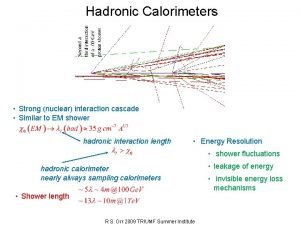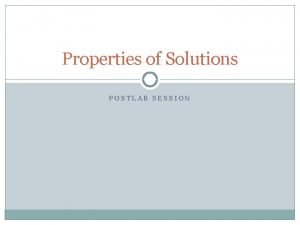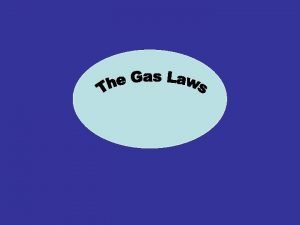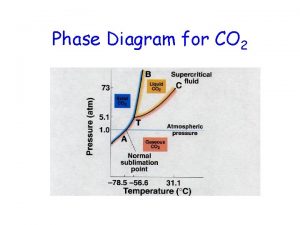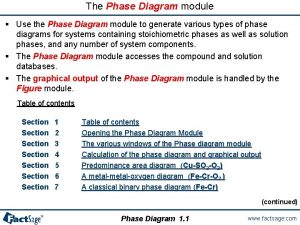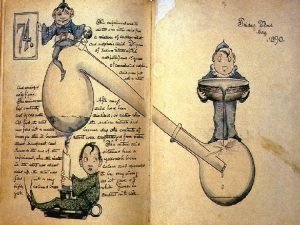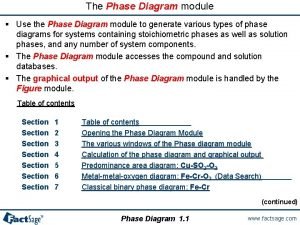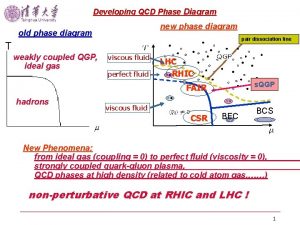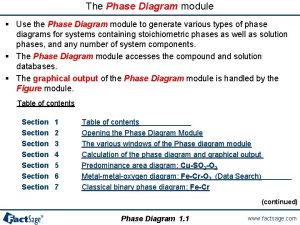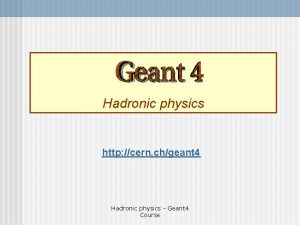First phase diagram of hadronic matter Consider phase












- Slides: 12

First phase diagram of hadronic matter Consider phase transition of hardonic matter at nonzero: T = temperature and μ = quark chemical potential ( = 1/3 baryon chem. pot. ) Cabibbo and Parisi ‘ 75: Exponential (Hagedorn) spectrum limiting temperature, or transition to new, “unconfined” phase. Assume “semi-circle” in plane of T and μ. Today: there is no semi-circle ρBaryon ↑ T→

Phase diagram, ~ ‘ 06 Lattice, T ≠ 0, μ = 0: two possible transitions; one crossover, same T. Karsch ’ 06 Remains crossover for μ ≠ 0? Stephanov, Rajagopal, & Shuryak ‘ 98: Critical end point where crossover turns into first order transition But still semi-circle in T and μ T↑ μ→

Cold, dense quark matter at large Nc Consider large number of colors: Nc → ∞, with g 2 ~ 1/Nc and small Nf ~1. Standard ’t Hooft limit. In general: any # gluon loops, but quarks only to 1 loop. Simple but general example: Debye mass at leading order: At T ≠ 0 and any μ, only gluons contribute: So trivially, the Debye mass is independent of μ. Conversely, at T = 0 and μ ≠ 0, the Debye mass is suppressed by 1/Nc: Conclude: cold, dense quark matter is confined until μ ~ Nc 1/2

Quarkyonic Matter Assume μ is large, but not “too” large: μ ≪ N 1/2, so there is confinement. However, also assume that μ ≫ ΛQCD = renormalization mass scale in QCD. Consider the pressure, computed in perturbation theory: Actually two kinds of log’s: log(μ/ΛQCD ), and log(μ/m. Debye) ~ log(1/g). Suggestive. Since μ ≫ ΛQCD , we can compute p(μ) perturbatively. But isn’t theory confined? ΛQCD Look at the Fermi sea: modes deep within are pert. Confinement only matters for light modes, near the Fermi surface. Since these are a “skin”, they only contribute ~ μ 2 ΛQCD 2 to the pressure. quark + baryonic = quarkyonic Mc. Lerran & RDP, 0706. 2191 μ

Phase diagram at large Nc Below: cartoon of phase diagram at large Nc. Clear separation of deconfining and chiral phase transitions. No semi-circle. But what about Nc = 3? T↑ Quark-Gluon Plasma, p ~ Nc 2 Triple Point Td ↑ μqk ~ Nc 1/2 Quarkyonic, p ~ Nc Dilute Nucleons, p ~1 Chiral Spiral, P~Nc X

New Phase Diagram of QCD T↑ μB →

New Phase Diagram of QCD “Semi”-QGP Lin, RDP, Skokov 1301. 7432 1312. 3340 Lin, RDP +… 1409. 4778 Hidaka, Lin, RDP, & Satow 1504. 01770 T↑ Critical Endpoint = Triple Point? Andronic…Mc. Lerran, RDP + … 0911. 4806 Kojo, Hidaka, Mc. Lerran & RDP 0912. 3800 Kojo, RDP & Tsvelik, 1007. 0248 Kojo, Hidaka, Fukushima, Mc. Lerran, & RDP 1107. 2124 Quarkyonic Chiral Spirals μB →

Two colors on lattice: where is Quarkyonic? Braguta, Ilgenfritz, Kotov, Molochkov, & Nikolaev, 1605. 04090 (earlier: Hands, Skellerud + …) Lattice: Nc = 2 (no sign problem!), Nf = 2 staggered quarks mπ ~ 400 Me. V, fixed T ~ 50 Me. V, vary μ. Find four “phases”: 0 ≤ μ < mπ /2 ~ 200 Me. V. Hadronic phase: confined, no condensates 200 < μ < 350 : Bose-Einstein condensate (BEC) of diquarks, “dilute baryons” 350 < μ < 600 : BEC (~BCS), dense baryons (pressure ≠ pert) 600 < μ < 1100 : Quarkyonic: pressure≈pert. , but confined (Wilson loop area law) Quarkyonic up to highest μ > 1 Ge. V. Nc = 2 is not large Nc <Wilson loop>↑ μ→ ↑ 1100 Me. V

When is perturbation theory valid? T ≠ 0, μ = 0 Consider first T ≠ 0: gluon propagator Braaten & Nieto, hep-ph/9501375: dominant p ~ 2 π T Laine & Schroder, hep-ph/0503061: by 2 -loop calc. in effective theory, find for Nc = 3: αs(T)↑ Band: change in effective αs(T), by varying Λpert by a factor of two. Even down to T ~ 150 Me. V, Λpert is still ~ 1 Ge. V. N. B. : effective theory resums modes with p ~ T, then p ~ g 2 T. T/ΛMS→

When is perturbation theory valid? μ ≠ 0, Τ = 0 Kurkela, Romatschke, & Vuorinen, 0912. 1856: pressure to ~ αs 2(T), 2+1 flavors (ms ≠ 0) Take Λpert from Debye mass, αs(T)↑ Λpert→

When is perturbation theory valid? μ ≠ 0, Τ = 0 Fraga, Kurkela, & Schaffner-Bielich, 1402. 6618: using Λpert ~ 2 μ: μ→

When is cold quark matter Quarkyonic? For perturbation theory in vacuum: valid for momenta p > Λvac = 1 Ge. V Suggest: Fermi momenta is a momentum. In strict analogy to vacuum: If μ > 1 Ge. V, Λpert ~ μ. For μ < 1 Ge. V , Quarkyonic or dense baryons. Ghisoiu, Gorda, Kurkela, Romatschke, Säppi, & Vuorinen, 1609. 04339: pressure(μ) ~ g 6. Will be able to compute Λpert = # μ. # ~ 1? μ→ Pure conjecture: Dense Baryons Quarkyonic Perturbative
 Hadronic
Hadronic Hadronic cascade
Hadronic cascade Section 1 composition of matter
Section 1 composition of matter Gray matter vs white matter
Gray matter vs white matter Classification of matter section 1 composition of matter
Classification of matter section 1 composition of matter Chapter 2 matter section 1 classifying matter answer key
Chapter 2 matter section 1 classifying matter answer key Optic tract
Optic tract Section 1 composition of matter
Section 1 composition of matter Gray matter and white matter
Gray matter and white matter Gray matter vs white matter
Gray matter vs white matter Flow of energy vs flow of matter
Flow of energy vs flow of matter Mongo seeds will dissolve in one cup water yes or no
Mongo seeds will dissolve in one cup water yes or no Phase changes of matter
Phase changes of matter

